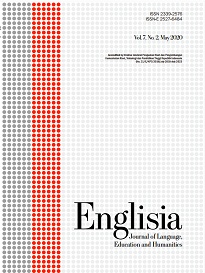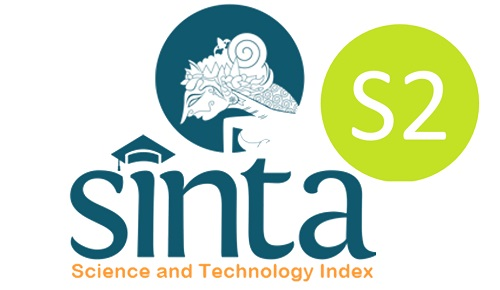EFL learners' difficulties in the structure and written expression section of TOEFL test in an Indonesian university
DOI:
https://doi.org/10.22373/ej.v7i2.6472Keywords:
EFL learners, structure, written expression, TOEFL TestAbstract
This study examined the English for Foreign Language (EFL) learners’ difficult topics in the structure and written expression section of the TOEFL Prediction Test, and reasons why they consider that these topics were difficult. A mixed-method research design was used in this study. Fifteen participants were selected through a purposive sampling mechanism from the seventh-semester students of the Department of English Language Education, Universitas Islam Negeri Ar-Raniry who have participated in the TOEFL Prediction Test to identify the difficult topics they encountered. Then, the semi-structured interviews were conducted with six underachieving student’s participants with the most recorded errors made in the test to know the reasons behind their difficulties. Findings indicated that students encountered difficulties mostly when dealing with determiners, conjunctions, adjective clauses, apposition phrases, and reduced clauses in the structure section. Meanwhile, adverb connectors, subject-verb agreement, and clause of concession, relative clause, and quantifier are the difficulties they encountered in the written expression section of the test. Thus, the findings also revealed several factors identified as the reasons behind those difficulties, namely lack of practice, grammar incompetence, vocabulary shortage, time management, and low self-confidence. Given the significant impact of this study, we suggested that the lectures and English departments should address these difficulties. It is crucial that the focus of the courses related to grammar and EFL proficiency tests be incorporated into the syllabus.
Downloads
References
Abboud, Z. A. R., & Hussein, N. J. (2011). The difficulties faced by advanced Iraqi foreign learners in passing the ITP TOEFL test. Journal of Basrah Wes (Humanities Series), 36(4), 110-138.
Adhabi, E., & Christina, B.A. (2017). Literature review for the type of interview in qualitative research. International Journal of Education, 9(3), 86-97.
Ahmed, A. H. (2010). Students' problems with cohesion and coherence in EFL essay writing in Egypt: Different perspectives. Literacy Information and Computer Education Journal (LICEJ), 1(4), 211-221.
Alqahtani, M. (2015). The importance of vocabulary in language learning and how to be taught. International Journal of Teaching and Education, 3(3), 21-34.
Alrabai, F. (2016). Factors underlying low achievement of Saudi EFL learners. International Journal of English Linguistics, 6(3), 21-37.
Alshammari, H. A. M. (2013). Effects of time constraint on second language reading comprehension (Doctoral dissertation, Southern Illinois University Carbondale).
Ananda, R. (2016). Problems with section two ITP TOEFL test. Studies in English Language and Education, 3(1), 35-49.
Annabel, B. K. (2005). Using interviews as research instruments. Chulalongkorn University: Language Institute.
Atmojo, A. E. P. (2018). Students' problems on SV agreement in TOEFL and their proposed solutions. Leksema: Jurnal Bahasa dan Sastra, 3(2), 169-175.
Aziz, A. L. (2016). The implementation of minimum TOEFL score-obtaining as a graduation requirement in higher education: students' perspective. International Journal of Management and Administrative Sciences, 4(3), 76-87.
Baker, W. (2012). English as a lingua franca in Thailand: Characterisations and implications. Englishes in Practice, 1(1), 18-27.
Baker, W. (2012). Global cultures and identities: Refocusing the aims of ELT in Asia through intercultural awareness. In Innovating EFL teaching in Asia (pp. 23-34). Palgrave Macmillan, London.
Brown, J. D. (2005). Testing in language program: A comprehensive guide to testing language assessment. NY: McGraw-Hill.
Chapelle, C. A., Enright, M. K., & Jamieson, J. M. (Eds.). (2011). Building a validity argument for the Test of English as a Foreign LanguageTM. Routledge.
Chujo, K., Oghigian, K., & Akasegawa, S. (2015). A corpus and grammatical browsing system for remedial EFL learners. Multiple affordances of language corpora for data-driven learning, 109-130.
Creswell, J. W. (2007). Qualitative inquiry and research design: Choosing among five approaches (2 ed.). Thousand Oaks: Sage.
Dang, T. K. A., Nguyen, H. T. M., & Le, T. T. T. (2013). The impacts of globalisation
on EFL teacher education through English as a medium of instruction: An example from Vietnam. Current Issues in Language Planning, 14(1), 52-72.
Darweesh, A. D., & Kadhim, S. A. H. (2016). Iraqi EFL learners' problems in using conjunctions as cohesive devices. Journal of Education and Practice, 7(11), 169-180.
Dehham, S. H. (2014). The performance of Iraqi EFL university learners in using English compound adjectives. Journal of University of Babylon, 22(2), 349-372.
Devira, M., & Makhroji, M. (2017). The EFL university students' problems in
answering the Test of English as a Foreign Language (TOEFL): A study in Indonesian context. In International Conference on Science, Technology and Modern Society (Vol. 1, No. 1, pp. 93-97).
Ebadi, S., & Khaksar, Z. (2014). The relationship between Iranian upper intermediate EFL learner's test anxiety level and their performance in writing test of TOEFL. IJLLALW2014, 6(4), 293-307.
Erfani, S. S. (2012). A Comparative washback study of IELTS and TOEFL iBT on teaching and learning activities in preparation courses in the Iranian context. English Language Teaching, 5(8), 185-195.
Esterberg, K. G. (2002). Qualitative methods in social research. E8
Farrokhi, F., & Sattarpour, S. (2012). The effects of direct written corrective feedback on improvement of grammatical accuracy of high-proficient L2 learners. World Journal of Education, 2(2), 49-57.
Fitri, M. (2018). The difficulties faced by the students in answering the written expression section of The TOEFL Test. Indonesian Journal of Integrated English Language Teaching, 3(2).
Gray, D.E. (20014). Doing research in the real world. First Edition. London: Sage Publications.
Griffe, D. T. (2012). An introduction to second language research methods: Design and data. TESL-EJ Publications. Berkeley, California, USA.
Guetterman, T. C. (2015). The development, design, and test of a self-assessment instrument of mixed methods research proficiency. The University of Nebraska-Lincoln.
Hajri, T., Jufrizal., & Wahyuni, D. (2018). An analysis of difficulties in answering structure and written expression of TOEFL made by English students' of universitas negeri padang. Journal of English Langauge Teaching, 7(1), 93-105.
Hambali, M. (2008). Shortcut strategies in analyzing sentence structure in TOEFL. Lingua: Jurnal Bahasa dan Sastra, 9(2), 82-88.
Hamid, M. O., & Kirkpatrick, A. (2016). Foreign language policies in Asia and Australia in the Asian century. Language Problems and Language Planning, 40(1), 26-46.
Hamid, M. O., & Nguyen, H. T. M. (2016). Globalization, English language policy,
and teacher agency: Focus on Asia. International Education Journal: Comparative Perspectives, 15(1), 26-43.
Hayes, D. (2017). Fallacies affecting policy and practice in the teaching of English as aforeign language in state primary schools in Asia. Asia Pacific Journal of Education, 37(2), 179-192.
Herwandar, R., Safryono, D. A., & Haryono, P. Y. (2012). Evaluasi program matrikulasi TOEFL mahasiswa Universitas Al Azhar Indonesia 2010/2011. Jurnal Al-Azhar Indonesia Seri Humaniora, 1(3), 179-188.
Hosseiny, M. (2014). The role of direct and indirect written corrective feedback in improving Iranian EFL students' writing skill. Procedia-Social and Behavioral Sciences, 98(1), 668-674.
Huang, J. (2006). English abilities for academic listening: How confident are Chinese students? College Student Journal. 40(1), 218-226.
Kasim, U. (2016, November). The implementation of TOEFL score as a requirement for script examination at Syiah Kuala University. In Proceedings of English Education International Conference (Vol. 1, No. 2, pp. 24-28).
Kawachi-Furlan, C. J., Amorim, G. B., & Finardi, K. R. (2017). The interface between the TOEFL ITP and internationalization and language assessment in Brazil. Interface, 5(2).
Kempa, R. (1991). Students learning difficulties in science: Causes and possible remedial. Ensenanza de Las Cienciai, 9(2), 119-128.
Mahmud, M. (2014). The EFL students' problem in answering the test of English as a foreign language (TOEFL): A study in Indonesian context. Theory and Practice in Language Studies, 4(12), 2581-2587.
Martono, E. (2013). The Effectiveness of Communicative Language Teaching method to enhance the students' motivation in increasing their TOEFL score. Language Circle: Journal of Language and Literature, 7(2).
Masfufah, S. (2018). Indonesian college students' perceptions of TOEFL preparation class. EduLite: Journal of English Education, Literature and Culture, 3(1), 66-78.
Miles, M. B., & Huberman, M. (2013). Qualitative data analysis: an expanded sourcebook (3rd ed.). London.
Netta, A., & Trisnawati, I. K. (2020). Acehnese undergraduate students' strategies in preparing For TOEFL prediction: A preliminary study. Englisia: Journal of Language, Education, and Humanities, 7(1), 41-52.
Nikolaieva, O. (2016). A qualitative study on preparing EFL students to take the TOEFL internet-based (iBT) test in the Ukrainian context (Master's thesis, University of Stavanger, Norway).
Nikolov, M. (2016). Trends, issues, and challenges in assessing young language learners. In Assessing young learners of English: Global and local perspectives (pp. 1-17). Springer, Cham.
Nimasari, E. P., Mufanti, R., & Gestanti, R. A. (2019). SEKOLAH TOEFL as a platform to integrate technology and online learning resources in ELT. Asian EFL Journal, 23(3.2).
Noviyenty, L. (2018). An evaluation of TOEFL matriculation program for STAIN students. English and Literature Journal, 5(1), 55-68.
Philips, D. (2001). Longman introductory course for the TOEFL test (2nd ed.). New York: Pearson Education, Inc.
Saadian, H., & Bagheri, M. S. (2014). The relationship between grammar and vocabulary knowledge and Iranian EFL learners' writing performance (TOEFL PBT essay). International Journal of Language Learning and Applied Linguistics World, 7(1), 108-123.
Samad, I.A. & Fitriani, S.S. (2016). English proficiency in facing ASEAN economic community: an opportunity or a challenge?. Proceedings of the 6th Annual International Conference Syiah Kuala University (AIC Unsyiah) in conjunction with the 12th International Conference on Mathematics, Statistics and Its Application (ICMSH), October 4-6, Banda Aceh, Indonesia.
Samad, I. A., Jannah, M., & Fitriani, S. S. (2017). EFL Students' strategies dealing with common difficulties in TOEFL reading comprehension section. International Journal of Language Education, 1(1).
Seyedtajaddini, K. (2014). The impact of audio input Enhancement on EFL learners'grammar learning from varying proficiency levels. Procedia-Social and Behavioral Sciences, 98(18), 1706-1712.
Sharpe, P. J. (2004). How to prepare for the TOEFL: Test of English as a foreign. New York: Barron's Educational Series
Snape, N. (2006). The acquisition of the English determiner phrase by Japanese and Spanish learners of English (Doctoral dissertation, University of Essex).
Stuckey, H. L. (2013). Three types of interviews: Qualitative research methods in social
Students. English and Literature Journal, 5(1), 55-68.
Subramaniam, R., & Khan, M. H. (2016). Explicit grammar instruction in communicative language teaching: A study of the use of quantifiers. Malaysian Journal of ELT Research, 9(1), 31.
Sudijono, A. (2006). Pengantar statistik pendidikan. Jakarta: PT Raja Grafindo.
Susanti, N. W. M. (2014). The use of paper-based TOEFL as a gate keeper for graduation: A case study at English department Universitas Mataram. In The 61st TEFLIN International Conference (pp. 1169-1172).
Takanashi, Y. (2004). TEFL and communication styles in Japanese culture. Language, Culture and Curriculum. 17(1), 1-14.
Todd, R. W., & Shih, C. M. (2013). Assessing English in Southeast Asia. The Companion to Language Assessment, 4, 1681-1689.
Warfield, W., Laribee, R., & Geyer, R. W. (2013). Examining result and establishing benchmark data from the TOEFL ITP test. American Academic & Scholarly Research Journal, 5(3), 191-198.
Woods, A., Fletcher, P., & Hughes, A. (1986). Statistics in language studies. Cambridge: Cambridge University Press.
Wulandari, N. (2016). Barriers of teaching TOEFL in Indonesia. Lantip: Jurnal Ilmu Sosial dan Ekonomi Universitas Respati Yogyakarta, 6(1), 1-12.
Xu, W., Case, R. E., & Wang, Y. (2009). Pragmatic and grammatical competence, length of residence, and overall L2 proficiency. System, 37(2), 205-216.
Downloads
Published
Issue
Section
License
Proposed Policy for Journals That Offer Open Access
Authors who publish with Englisia journal agree to the following terms:
- Authors retain copyright and grant the journal right of first publication with the work simultaneously licensed under a Creative Commons Attribution License that allows others to share the work with an acknowledgement of the work's authorship and initial publication in this journal.
- Authors are able to enter into separate, additional contractual arrangements for the non-exclusive distribution of the journal's published version of the work (e.g., post it to an institutional repository or publish it in a book), with an acknowledgement of its initial publication in this journal.
- Authors are permitted and encouraged to post their work online (e.g., in institutional repositories or on their website) prior to and during the submission process, as it can lead to productive exchanges, as well as earlier and greater citation of published work (See The Effect of Open Access).









